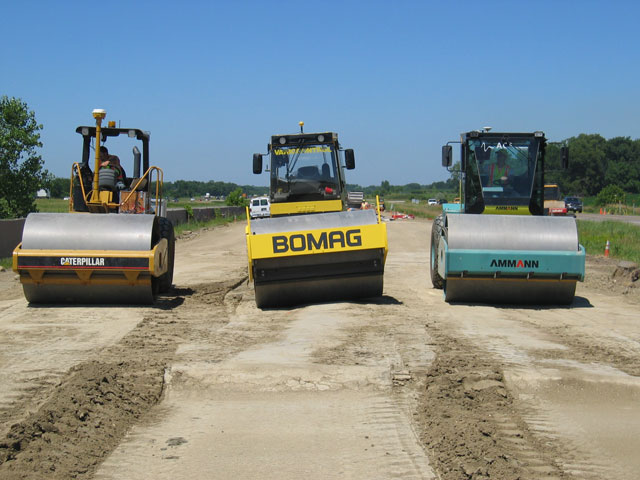Project Details
07/01/06
10/31/10
Ammann Construction Equipment
Bomag Americas, Inc.
Case Construction Equipment
Caterpillar
Dynapac
National Cooperative Highway Research Program 21-09
Sakai Heavy Industries Ltd.
State DOT Partners: MN, NC, FL, MD, CO
Transportation Research Board
Trimble Navigation
Researchers
Michael Mooney
David White
Robert Rinehart
Normal Facas
Mark Thompson
Pavana Vennapusa
Odon Musimbi
About the research
The NCHRP Project 21-09, “Intelligent Soil Compaction Systems,” was undertaken to investigate intelligent soil compaction (IC) systems and to develop generic specifications for the application of IC in quality assurance (QA) of soil and aggregate base material compaction. The term intelligent soil compaction systems was defined to include (1) continuous assessment of mechanistic soil properties (e.g., stiffness, modulus) through roller vibration monitoring; (2) automatic feedback control of vibration amplitude and frequency; and (3) an integrated global positioning system to provide a complete geographic information system-based record of the earthwork site. An equally important term is roller-integrated continuous compaction control—defined by IC components (1) and (3).
Roller-integrated continuous compaction control (CCC) technology was initiated in Europe in the 1970s and has been used in European practice for nearly 20 years. The first European specification for roller integrated CCC was developed in Austria in 1990. Today, four European countries have soil compaction QA specifications using roller-integrated CCC (Austria, Germany, Sweden, and Switzerland) and U.S. states are beginning to implement pilot specifications (e.g., Minnesota). In European specifications the use of automatic feedback control IC rollers is permitted during compaction but not during QA because the roller measurement values (MVs) can be strongly influenced by varying amplitude and frequency. The dependence of roller MVs on frequency and amplitude in particular was verified in this study and further determined to be quite complex and difficult to predict. Accordingly, the recommended specifications developed here allow IC during compaction but do not permit the use of automatic feedback control IC during roller-based QA.
The following are the key items covered in this project:
- Recommended Specifications for Roller Integrated CCC in Earthwork QA
- Fundamentals of Roller Measurement Systems
- Relationship Between Roller-Measured Stiffness and In Situ Stress-Strain-Modulus Behavior
- Evaluation of Automatic Feedback Control-Based Intelligent Compaction
- Correlation of Roller Measurement Values to Spot-Test Measurements
- Case Study Implementations of Recommended Specifications
Researchers
Terry Wipf
Wayne Klaiber
About the research
The nation’s transportation system includes not only the extensive National Highway System but also the local highway systems that provide important links in the transportation network. Bridges are an essential component of these local systems. The primary focus of this synthesis is on local or off-system bridge design, construction, maintenance, financing, rehabilitation, and replacement. The definition of ?off-system? can vary from place to place. Off-system bridges in this report will refer to those bridges typically owned and maintained by local agencies (i.e., cities and counties) and by state agencies on rural and other low volume roads. Information was gathered from several sources, including a project survey, published literature, electronic media, personal contacts, and manufacturers of bridges or bridge-related products. Several current practice areas that need improvement (e.g., design standards, replacement strategies, and maintenance) were also identified.




